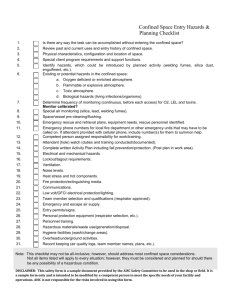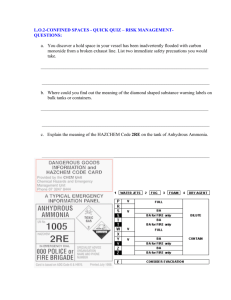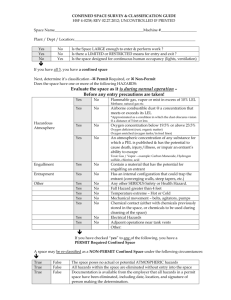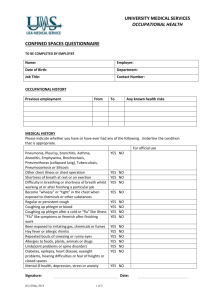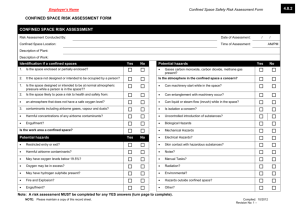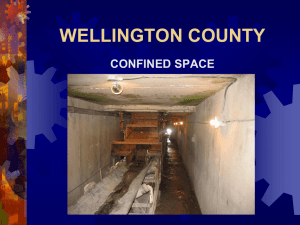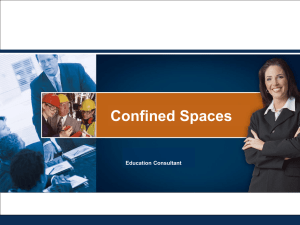Confined Spaces Power Point
advertisement
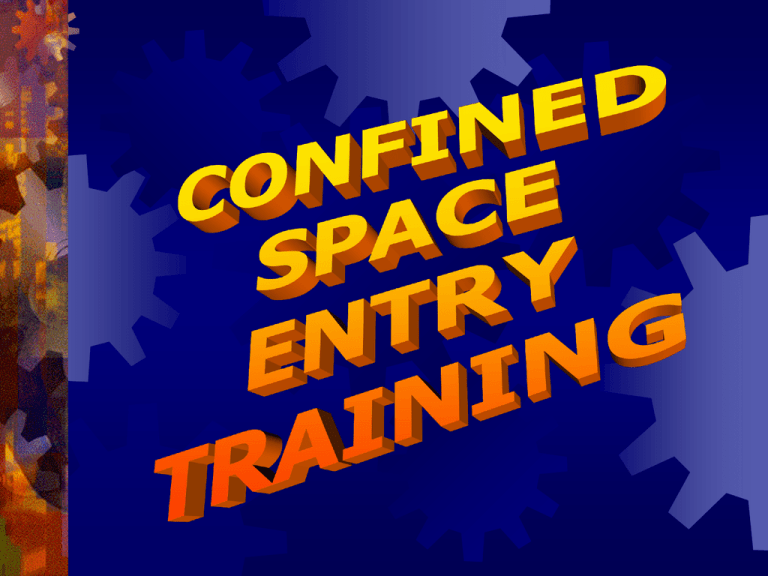
ASK YOURSELF… What is a confined space? What is difference between permitted and non-permitted confined spaces? List 3 examples of permitted confined spaces. When do I need PPE? When should I test the atmosphere? What is the safe oxygen level? COURSE OBJECTIVES Help you understand the criteria of a confined space Motivate you to evaluate your workplace and written programs Implement changes where necessary COURSE GOAL Prevent personal injuries/fatalities relating to a confined space entry COURSE WILL ADDRESS… Definitions of terms, with examples The The basic entry procedure components of a written program 1. CONFINED SPACE: Is large enough to enter into and work Has a limited means of entry/exit Is NOT designed for continuous periods of occupancy CLASSES OF CONFINED SPACE Class A – IDLH atmosphere. May contain oxygen deficiency, explosive or flammable atmospheres, and /or concentrations of toxic substances. CLASSES OF CONFINED SPACES cont’d Class B – space has potential for causing injury if proper safety steps are not followed CLASSES OF CONFINED SPACES cont’d Class C – space has potential hazards, but would not require any special modification of the work procedures. TYPES OF CONFINED SPACE… Non-Permitted does NOT contain physical, chemical or atmospheric hazards capable of causing death or serious physical harm … Permitted … DOES contain physical, chemical or atmospheric hazards capable of causing death or serious physical harm NOTE: The classification of ANY confined space SHALL be determined ONLY BY Trained AND Authorized persons EXAMPLES OF CONFINED SPACES: Tanks, vessels, silos, storage bins, hoppers, vaults, pump stations, scale pits, crawl spaces, tunnels… BOILER TANKS… PIPE CHASES… CRAWL SPACES… MANHOLES… PITS... 2. ENGULFMENT A liquid or a “flowable” solid like sand or grain that can surround and bury, smother, strangle, or crush a person. EGULFMENT cont’d Trenches deeper than 4ft Engulfment hazard: cave-in Preventive measure: shoring & evacuation route 3. IDLH Continued Immediately Dangerous to Life and Health Poses an immediate or delayed threat to life, OR… Causes irreversible adverse health effects, OR… Interferes with ability to escape unaided from a permit space 3. IDLH, May cont’d be used to determine need for PPE MSDS’s List If of IDLH values conditions meet or exceed IDLH values, implement PPE 4. QUALIFIED PERSON Designated by the employer in writing, as CAPABLE (by education, training, or both) of: Anticipating, recognizing, and evaluating employee exposure to hazardous substances or other unsafe conditions in a confined space; AND of Specifying necessary control and/or protective action to ensure employee safety 5. ATTENDANT An observant, competent/experienced person stationed outside of a confined space to assist the entrant 6. AUTHORIZED ENTRANT worker authorized to enter a confined space A 7. ENTRY SUPERVISOR The employee responsible for overseeing the Confined Space entry operations; permit signing; and safety compliance GENERAL CS ENTRY PROCEDURE 1. 2. 3. 4. 5. Conduct an assessment Post signage; Barricade Write the Permit Perform pre-entry tests Follow all other safety procedures PPE LO/TO Ventilation GENERAL CS ENTRY PROCEDURE, cont’d 6. Pre-entry briefing 7. Perform entry & work 8. Perform continuous atmospheric tests 9. Exit the confined space 10. Debrief employees/contractors 11. Verify completion ASSESSMENTS MUST INCLUDE: 1. Pre-entry testing and monitoring of/for: Atmospheric conditions Potential hazards in and around the area POTENTIAL HAZARDS Deficient Safe or enriched oxygen level: 19.5% - 23.5% Combustible, flammable, and explosive atmospheres Toxic gases and vapors Corrosive chemicals or biological agents POTENTIAL HAZARDS cont’d Physical hazards– Falling,tripping,moving parts,engulfment,heat extremes,etc… Electrical hazards— Shock hazard, static electricity, sparks, etc… Rodents,snakes, and insects ASSESSMENTS MUST ALSO INCLUDE: 2. Written procedures to remove or control hazards including ventilation, LOTO, PPE and communication 3. Written emergency response POSTED SIGNAGE MUST be in the immediate area MUST identify the Confined Space Restricts unauthorized personnel E.G.: “DANGER—PERMIT REQUIRED CONFINED SPACE, DO NOT ENTER” BARRICADES MUST prevent unwanted access to the work area MUST ensure clear workspace for attendant and emergency rescue (if needed) PERMITS Are written authorization and approval specifying the location and type of work Certify that all existing hazards have been assessed Ensure the safety of each worker Specify the date & length of time it applies Confined Space Permit NOTE: PERMITS ARE ALWAYS POSTED IN THE WORKPLACE DURING ENTRY TESTING STANDARDS Duration—Recommend continuous Sample priority—Oxygen; Flammable/combustible chemicals; Toxic chemicals TESTING METHODS Sample Every in layers four feet in direction of travel Different chemicals stratify Do not get equipment wet!! CHEMICAL STRATIFICATION *Chemicals will stratify according to their vapor density *Strata changes with environmental conditions (ex. Temperature and pressure) REMEMBER TO DOCUMENT ALL ATMOSPHERIC TESTING RESULTS!! OTHER SAFETY PRECAUTIONS PPE Lockout/Tag out Verify emergency response Remove sources of hazardous materials outside of confined space Ventilation VENTILATION Exhaust Negative pressure Local - for specific sources General - for non-specific sources Purging Positive pressure Using inert gases in flammable/combustible environment Causes need for additional PPE PRE-ENTRY BRIEFING Conduct meeting Include all affected persons Document topics discussed at the briefing. Entry documentation Each entrant should sign an entry log Posted in immediate area Follow work procedures and safety rules for job task!!! CONTINUOUS MONITORING REMEMBER methods! the mentioned sampling EXITING THE CONFINED SPACE When work is complete, when replacement arrives, or if an alarm sounds In the event of an emergency, utilize emergency rescue Remember to update the entry log!! ON-SITE RESCUE Employer determined if on/off-site rescue will be used On-site, usually comprised of inhouse personnel— Motivated team Extensive training Practical exercises (min. once/12 months) Regular reinforcement of training OFF-SITE RESCUE Assessment Determine necessary the practicality of off-site rescue If used: Close proximity Extensive pre-coordination Must understand the hazards to be faced Must have access to all spaces for preplanning DEBRIEFING Discuss the success of the work Identify concerns that occurred Verify completion of all documentation Document meeting, if possible VERIFY COMPLETION The entry supervisor should remain for at least 30 minutes after the entry to ensure the security of the site and that no hazards remain (ex. Fires) PROGRAM ELEMENTS: Identification and location of ALL recognized confined spaces Hazard evaluation procedures Warning procedures Ex: Signs at entrance MORE ELEMENTS… Written procedures for pre-entry and entry Written procedures for permitting MORE ELEMENTS… Assignment of responsibilities Entrant Attendant Entry supervisor ENTRANT Know the hazards associated with the space Follow the instructions on the permit Use required equipment properly ENTRANT cont’d Continually communicate with attendant Alert the attendant when necessary Exit the space quickly when required ATTENDANT Continued Know the hazards associated with the space Be aware of the effects of hazardous exposures Maintain accountability of entrants ATTENDANT cont’d Remain on duty until properly relieved Monitor the status of the entrant as appropriate Communicate with the entrant as appropriate ATTENDANT cont’d Continued Summon rescue and/or emergency assistance Monitor activities inside and outside the space Perform non-entry rescue in accordance with policy ATTENDANT cont’d Perform no duties that interfere with attendant duties Order evacuation of the space when dictated SUPERVISOR Continued Know the hazards associated with the space Ensure all entries on the written permit are appropriate Ensure all tests, procedures and equipment are used SUPERVISOR Terminate cont’d entry authorization when appropriate Verify that rescue services are available Verify methods are in place to summon rescue services SUPERVISOR cont’d Remove unauthorized individuals attempting entry Determine when transfer of responsibility takes place Ensure operations are consistent with the permit SUPERVISOR cont’d Perform non-entry rescue in accordance with policy Perform no duties that interfere with supervisor duties Emergency Response Attendant alerts the rescue services Close off the area Get authorized entrants out of the space Perform first aid if needed. Chest or body harnesses are worn by authorized entrant to allow for safe rescue. EXAMPLES… TRAINING REQUIREMENTS New employees At time of employment, if affected…or… When delegated affected responsibility Existing employees Refresher training Rescue drills at least annually TRAINING CONTENT All aspects of the written program Emergency procedures Document all training activities RECORD KEEPING REQUIREMENTS Written program Training records Atmospheric testing records Permitted and non-permitted entries into confined spaces Let’s review… What is a confined space? What is difference between permitted and non-permitted confined spaces? List 3 examples of permitted confined spaces. When do I need PPE? When should I test the atmosphere? Let’s review… What is the safe oxygen level? What are the 2 options for emergency response? Where should the permit be maintained during entry? When should an entrant exit the confined space? FOR ADDITIONAL ASSISTANCE… Call your Loss Prevention Representative
